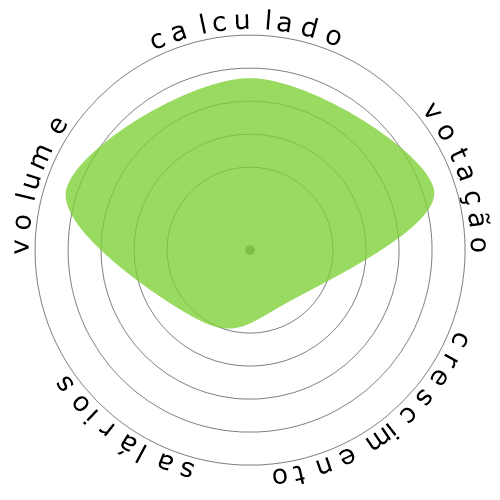Enfermeiros Licenciados Práticos e Vocacionais




As pessoas também visualizaram
Risco de automação calculado
Risco Baixo (21-40%): Trabalhos neste nível têm um risco limitado de automação, pois exigem uma mistura de habilidades técnicas e centradas no ser humano.
Mais informações sobre o que é essa pontuação e como ela é calculada estão disponíveis aqui.
Enquete do usuário
Nossos visitantes votaram que há uma baixa chance de esta ocupação ser automatizada. Esta avaliação é ainda mais apoiada pelo nível de risco de automação calculado, que estima 24% de chance de automação.
O que você acha que é o risco da automação?
Qual é a probabilidade de que Enfermeiros Licenciados Práticos e Vocacionais seja substituído por robôs ou inteligência artificial nos próximos 20 anos?
Crescimento
Espera-se que o número de vagas de emprego para 'Licensed Practical and Licensed Vocational Nurses' aumente 2,6% até 2033
Emprego total e estimativa de vagas de emprego
As projeções atualizadas são devidas 09-2025.
Salários
Em 2023, o salário anual mediano para 'Licensed Practical and Licensed Vocational Nurses' foi de $ 59.730, ou $ 28 por hora
'Licensed Practical and Licensed Vocational Nurses' receberam 24,3% a mais do que o salário médio nacional, que era de $ 48.060
Salários ao longo do tempo
Volume
A partir de 2023 havia 630.250 pessoas empregadas como 'Licensed Practical and Licensed Vocational Nurses' dentro dos Estados Unidos.
Isso representa cerca de 0,42% da força de trabalho empregada em todo o país
Dito de outra maneira, cerca de 1 em 240 pessoas são empregadas como 'Licensed Practical and Licensed Vocational Nurses'.
Descrição do trabalho
Cuidado com pacientes doentes, feridos, convalescentes ou pessoas com deficiências em hospitais, lares de idosos, clínicas, casas particulares, lares coletivos e instituições similares. Pode trabalhar sob a supervisão de uma enfermeira registrada. Licenciamento necessário.
SOC Code: 29-2061.00


Comentários
As an example, take the humanised skill of empathy. Empathy is the emotional skill to understand and share the feelings of another person. This shared emotional connection is something many, if not all, patients crave and desire. Empathy is something that AI cannot replicate well. In order for empathy to occur between two individuals, both individuals must be capable of emotions. Humans are capable of emotions, but AI robots are not. Emotions are biological, chemical, and mental reactions to certain stimuli. These reactions are uniquely inherent to organic living biological beings. An AI robot is not an organic living being, and thus cannot produce emotions. The best an AI can do is be programmed in a way to say certain things when a patient exhibits particular facial responses or verbal/tonal nuances. However, there is more to empathy than just being responsive. There exists a shared feeling that a human can only feel with another human, or another animal, especially when one of those humans is in a medically ill or injurious state.
Critical thinking serves as another example of a humanised skill that AI will find difficult to replicate. Critical thinking is the intellectual act of considering certain concepts, and constructing a charitable and objective take on said concepts through abstract reasoning or empirical evidence. To further this, the more unique and nuanced those concepts are, the more difficult it will be to critically think about said concepts. In the healthcare settings that LVNs find themselves in, there exists many unique concepts, or in this case, situations. I will illuminate one and that would be the case of patients with severe dementia. Patients with this mental condition may showcase behaviour that includes, but not limited to, loud screaming, random crying and potential desires for killing. What to do with these kind of patients is something LVNs face on a daily basis. Should the LVN just ignore the patient? Doing so may endanger the patient to him or herself, or worse, endanger other patients situated in the same room. Ignoring patients is also considered abuse in healthcare settings. On the other hand, ignoring the patient may allow the LVN to give care to other patients with much more debilitating conditions in the meantime, and thus allowing the LVN efficient time management. The LVN can also attend to that patient first, but only to administer medication that will calm him down, and make the LVN’s work less difficult. This may prove detrimental, if a family member of another patient asked the LVN to administer medicine to him first, because he missed a dose earlier in the day. With all this in mind, one can see how as an LVN there are many factors that they have to consider when making a reasonable decision, such as proper ethics, personal feelings, logical order of work, and so on. The LVN must be able to evaluate these factors and utilise his intellectual capacity for reason to support making the right decision. An AI’s intellectual capacity is much more rigid than a human’s mind. An AI robot cannot improvise at any given moment in the same fashion as a human. Unique situations, such as the aforementioned dementia case, requires a mind being able to asses many nuanced factors unique to the situation. Unfortunately, AI is just not capable yet of such critical thinking.
Deixe uma resposta sobre esta ocupação